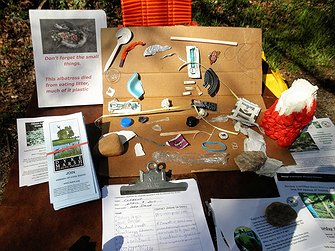Wednesday, April 24, 2024
A mysterious teal blue plastic bottle is nestled in the cattails and spatterdock plants of Dyke Marsh. The 28-ounce, blender-type bottle, with a Global Position System (GPS) tracking device inside, traveled south 16 miles from the upper reaches of the Anacostia River in two months and is stuck in the muck.
Researchers at the Smithsonian Institution’s Environmental Research Center launched 43 tracker bottles across the Anacostia River watershed in late January, part of a nationwide project with the Ocean Conservancy and the University of New Hampshire to model how trash moves through urban streams. They are tracking the bottles’ movement until August and then will retrieve them. Of the 43 bottles, the “Dyke Marsh bottle” traveled the longest distance so far.
The tracking study can help people better understand plastics’ movement patterns and whether plastic debris travels to oceans and whether it stays local or deposits onto beaches and shorelines close to rivers’ mouths. The conclusions can help inform cleanup, reduction and prevention strategies, the sponsors maintain.
The Smithsonian researchers cite a 2021 study on global annual plastic emissions from rivers that found that there may be as much as 2.7 million metric tons per year entering oceans each year which represents 25 percent of all plastics entering the ocean. That study concluded that 1.6 percent of the 100,887 rivers and streams studied accounted for over 80 percent of annual plastic entering the ocean from rivers. A Pew Charitable Trusts study predicts that given current trends, the amount of plastic waste entering the world’s oceans will triple to nearly 32 million tons a year by 2040.
Plastic Pollution, a Growing Menace
An organization called Beyond Plastics reports that worldwide one million single-use plastic bottles are purchased every minute and that less than one-third are recycled. For all plastics, only five to six percent are recycled in the U.S.
Around 40 percent of plastic produced is used for disposable packaging. Ocean Conservancy volunteers have collected nearly nine million plastic foam cups, plates and carryout food containers since 1986. Virginians use 320 single-use plastic bags a year each or three billion a year, according to Litter Free Virginia.
Plastics break down into smaller and smaller pieces called microplastics, pieces less than the size of a pencil eraser. Some come from larger plastic debris and some are manufactured as microbeads. Birds and aquatic animals can mistake plastic for food. Some studies show the presence of microplastics in human organs.
400 Pounds of Trash
On April 20, 100 volunteers hauled out 40 bags or 400 pounds of trash from the Potomac River shoreline of Belle Haven Park and in the Dyke Marsh Wildlife Preserve in two hours. Among myriad items, volunteers found a tire, shoes, balls, a life jacket and many plastic bottles and pieces. A substantial proportion of the items collected were plastic. At a Feb. 24 shoreline cleanup, volunteers also collected 400 pounds of trash.
Clean Virginia Waterways cites plastic bottles as the number two item found during coastal cleanups. Other plastic trash on their top 20 list are bags, cups, plates, utensils, food wrappers, bottle caps, straws, balloons, fishing line and six-pack holders.
Most of the mismanaged trash in rivers has land-based sources. It gets there from intentional and accidental discards, illegal dumping, the wind, overfilled bins and people littering.
“Though all types of aquatic trash can have potentially harmful impacts, plastic waste is particularly concerning because of its tendency to persist in the environment and its widespread production and disposal,” says the U.S. Environmental Protection Agency’s website.
